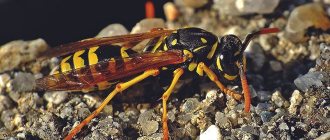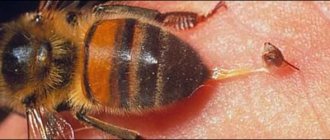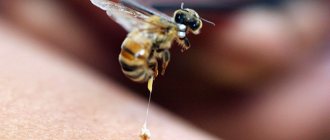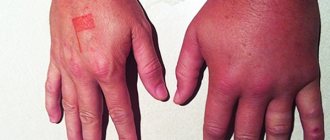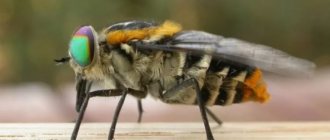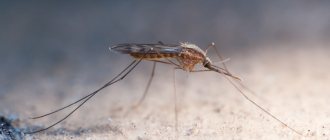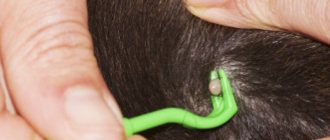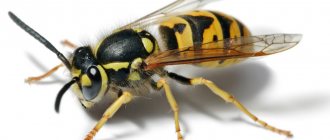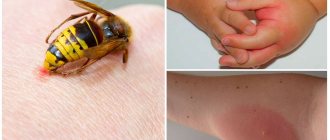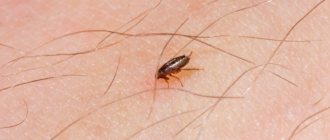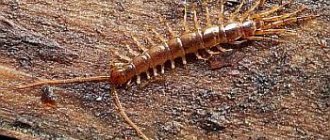Who dies after being stung: a bee or a wasp?
Insects use their stings for hunting, as well as self-defense and protection of the hive. Bees are not known for their aggressive disposition; they use their stings in emergency situations. Once stung, they continue to live for about 30 minutes. The bee sting has serrations that resemble a saw in appearance. Easily penetrates the skin, but cannot move back. After the jerk, the bee leaves the sting inside along with part of the abdomen. A few minutes later he dies.
On a note!
What happens to the wasp after a sting depends on the circumstances. The sting is needle-shaped. The surface is smooth, without jagged edges, protrusions, or thorns. It penetrates the skin easily and can be removed just as easily. In one attack, the wasp can bite up to 5 times, after which it quickly flies away.
Whether an insect dies or not - under such circumstances, no. Continues normal life activities and returns to the hive. However, it takes some time to recuperate. The wasp uses venom in special cases. When confronted with a potential victim, it uses its powerful jaws, and only then stings.
How wasps bite
The wasp's main weapon is its sting, which is an amazing and complex mechanism. Only females are equipped with “perfect weapons,” since the sting is nothing more than a modified ovipositor. Located at the end of the abdomen. When the insect is at rest and does not try to hunt anyone, the sting is hidden inside the body.
In case of danger, with the help of muscles, the tip of the sting moves outward. When attacked, the tip pierces the victim's skin and poison is injected. A person experiences pain not at all from a puncture, but from substances that are part of insect venom and cause allergic reactions, burning, itching.
On a note! The wasp sting is one of the sharpest devices in the world.
What happens to the wasp after a bite: using the same muscles, the sting is retracted back, and the wasp itself flies away further if the person does not injure himself while trying to swat the aggressor. In rare cases, a wasp may sting several times until the venom supply runs out.
Why does a bee die after being stung, but not a wasp?
Many people repeatedly have to deal with bee or wasp stings. These insects fly especially often near flowering plants or trees, near sweets. Wasps can build a nest even on the balcony. Therefore, meeting these insects is not at all difficult.
The first thing a person feels after a bite is pain. A natural reaction arises - to take revenge on the offender. But often the bee or wasp simply flies away, leaving its stinger in the human skin.
Important: In fact, a bee sting is not harmless, even if it managed to fly away. Bees have it worse than humans. After all, it is known that after a bee stings, it dies.
Why is this happening? The bee's sting looks like a small harpoon - a point with small serrations. When the sting pierces a person's skin, the bee can no longer reach it back due to the fact that the elastic skin tightly compresses the barbs. The bee, in an attempt to reach its sting, tears off part of its intestine and flies away. The resulting injury leaves the bee no chance of survival, and the insect soon dies.
The situation is completely different with wasps. Unlike a bee's sting, a wasp's sting is smooth. If you look at the sting of a wasp and a bee under a microscope, you can see the difference. The wasp easily removes its sting after a bite and pulls it back into the abdomen. It is for this reason that a wasp can sting several times in a row until it splashes out all the poison. Even if for some reason, for example, when a person tries to kill a wasp, the sting remains in the skin, the insect does not die. The wasp simply loses its ability to sting a person.
This is what a bee and wasp sting looks like
Important: A wasp sting is one of the sharpest devices in the world. Some wasp stings are not only safe, but can also be beneficial. Scientists have proven that Brazilian wasps secrete poison that destroys cancer cells. The venom of such wasps acts selectively and does not damage healthy cells.
The sting of a bee or wasp is a complex tool. It is located in the abdomen. Thanks to the flexibility of the insect's body, the sting hits the target exactly. Worker bees and queen bees have a sting; drones do not have such an organ. In queens, the sting is a modified ovipositor; queens are not capable of stinging a person or animal. Worker bees sting, we'll talk about the reasons below.
Human bee sting
How to Avoid a Bite
A bee, its bite and sting.
To avoid a bite and save the life of a useful creature, you need to follow certain rules:
- You should not run, make sudden movements, or wave your arms at the sight of a striped creature. You need to stop, freeze, wait for the insect to fly away. Even if it lands on a person’s skin, it will not bite unless there is a danger to its own life.
- When going outdoors in the spring, you should not wear bright clothes or walk barefoot on the grass. Such actions provoke bees, which are in constant search of pollen and flowers.
- You should not use sweet-smelling perfumes.
- Be careful when picking berries and eating fruits on the street.
To avoid trouble, it is worth studying the differences between a bee and a wasp and their bites. The latter are distinguished by aggressive behavior, capable of biting several times in one minute. The body of the wasp is oblong, while that of the bee is round. The latter tries to quickly move away from the person; the wasp can become annoying, circling over the head and body for several minutes. After the bite of any of these insects, swelling, redness, pain, and burning occur. The main difference is that a bee leaves a sting, a wasp does not. Bee venom is more dangerous because the capsule remains inside the person, the wasp releases only a small portion of the venom.
The structure of a wasp sting
Female wasps use their sting for defense and attack. Its role is to paralyze the victim. If it is an insect, it is taken to the wasp hive for food.
The sting consists of:
- poison gland;
- pointed proboscis;
- internal duct.
It is through the internal duct that the poison from the gland enters the victim. The shape resembles a regular needle. Although it is thin, it is quite strong, as it consists of chitin. The formation of the weapon begins in the egg, so males, in principle, do not have the opportunity to possess it. The length of the sting is impressive, since the wasp extends it when biting. The proboscis and duct can be examined using a microscope.
Does the wasp bite or sting?
The wasp is known to have a sting. But it turns out that not every individual has it, but only females. With its help they defend themselves or attack. A wasp hive is mainly filled with females, so it is believed that all individuals have a sting.
These insects are also armed with sharp, strong jaws that can easily bite through chitin. A wasp bites when attacked by insects. But when faced with a person, she uses a sting to release her poison from him. She does not stop at one bite, but tries to hit the person several more times in order to inject as much poison as possible. Depending on the age, type and volume of poison, the wasp stings at least 5 times.
Interesting! If an insect senses danger, someone attacks the nest - a special signal is given to other individuals. The enemy receives a lot of bites from the entire swarm.
How dangerous is the poison?
The insect is dangerous because its poison can cause a severe allergic reaction, even leading to death. Many people are unaware of their high sensitivity to this poison until the moment they are bitten. Although wasps sting quite often. The bite is accompanied by sharp pain, the wound swells, and a burning sensation is felt. This is the least you can get away with in such a situation. The consequences may be unforeseen.
The poison contains substances such as:
- phospholipase;
- melitin;
- histamine, etc.
The whole difficulty lies in the fact that without encountering a wasp, it is impossible to know about the presence of sensitivity to these substances. Therefore, an attack by a stinging insect can lead to unpleasant consequences and even death, although this is a very rare occurrence.
The properties of substances also include:
- destruction of body cells;
- causing tumor;
- triggering allergies;
- impact on the nervous system.
It is because of the action of the poison that the bite site becomes inflamed and does not heal for a sufficiently long period of time. Itching may also add to the pain. If the pain does not go away after 2 weeks, it is best to consult a doctor.
How much and how long the wound hurts may depend on the type of insect that stung. The bite of some individuals may be completely painless, while others will lead to suffering.
Most bites occur on the arms and legs. But cases of stinging in the head also occur. If the sting gets into the face, it may change beyond recognition. The eyelids swell to such a size that the eyes cannot see anything. Bites on the tongue often occur. This happens when a wasp sits on food, but a person did not notice it and took it into his mouth. The swollen tongue becomes so large that the mouth may not close.
Better in the leg than in the stomach
In general, the insects are in trouble, the hospitals are full houses. Doctors say that people die from bee and wasp bites three times more often than from snakes. The main reason is a severe allergic reaction, which, according to statistics, occurs in one in 250 people.
“In recent days, the number of people seeking medical help after a bite has sharply increased,” admits allergist Lyudmila Gordienko. – People with allergies and asthma are at risk. Wasp venom acts as a strong allergen on some people. The location of the bite also matters. If it hits the chest, abdomen, or head, the consequences can be more severe than if a person is stung in the leg or arm. If you have a severe allergy to the venom of Hymenoptera, if immediate help is not provided, even death is possible.
The most dangerous bites, warns the allergist, are in the oral cavity. For example, if you bite off a piece of watermelon or an apple that a wasp was sitting on, your airways may begin to swell.
To avoid being an accidental victim of a small but evil striped mischief, experts advise opening the windows in the house after sunset, when all the bees and wasps have returned to their nests. Wasps, for example, love rotting fruit, food waste, sweet foods and drinks. So don't leave spoiled treats in the kitchen, keep the trash can closed. Avoid walking barefoot or wearing open shoes on grass, especially near flowering bushes. Before you smell the bouquet, make sure there are no insects on the flowers. The wardrobe will also have to be reconsidered - bees may be attracted to a bright dress with flowers. An insect may confuse you with a rose or a lily, sit down, and then it’s not far from being bitten.
How long do wasps live?
In early spring, the young queen begins building a nest and laying eggs. All summer, immature females appear - working individuals. They perform different functions, provide hive construction, protection, obtain food, and feed larvae. Life expectancy is no more than a month. The wasp society is rapidly expanding. By the end of summer the population numbers several hundred individuals.
In August, the wasps begin to attach additional honeycombs, which are slightly larger in size. There the queen lays eggs, from which females and males emerge. After birth, they remain in the hive for some time, then fly outside to mate.
Working individuals eat larvae, underdeveloped eggs, and leave the nest, on the construction of which they worked throughout the warm season. At the beginning of autumn they become slow and not so aggressive. With the onset of the first frosts they begin to die. Young queens hide in tree hollows, crevices, and wooden buildings. According to some sources, old queens die along with their family, according to others, they winter safely and live for about 2 years.
The bite does not affect life expectancy unless the person intentionally kills the attacker. In most cases, death occurs naturally or during a confrontation with a natural enemy.
Features of the bite
The statement that a wasp dies after biting a person is incorrect. This happens if a person intuitively swats an insect. But in most cases, he shakes off the pest, throwing it away from him.
Wasp and bee sting
The sting is used by the insect for hunting and self-defense. However, any human movement is regarded as aggression, and the wasp rushes to attack. Landing on the body, it compresses the abdominal muscles and launches a sting. Instantly launches poison. If a person waves his arms or makes sudden movements, the attack can occur again, up to 5 times.
On a note!
When a wasp bites or dies, a secret is released that is sensed by other relatives. If there is a nest nearby, in a few seconds you will have to fight off a whole swarm. In this case, a dead wasp is more dangerous than a living one, so you need to try to get rid of the insect, but not kill it.
Medications
Of course, there are medications in different forms to relieve pain and swelling.
Medicines to relieve swelling, redness and itching
Menovazin and Lidocaine in the form of an ointment or solution help relieve swelling from a wasp sting and relieve pain It’s good to treat the bite site with the good old Star .
Panthenol helps stop inflammation, disinfect and accelerate tissue regeneration . You need to smear the bite with this remedy several times a day.
In case of suppuration and signs of secondary infection, a local antibiotic Levomekol .
What should you not do?
If you are stung by a wasp, you should not squeeze out the poison or pick at the wound with a needle in search of the sting. This can speed up the entry of poison into the blood and facilitate the penetration of a secondary infection. You should not drink alcohol, as it accelerates the spread of poison in the blood and increases the risk of an allergic reaction.
First aid for a bee or wasp sting
A bee or wasp injects poison into the human body using its sting. Therefore, the skin swells, turns red and hurts. If you have been stung by a wasp or a bee, you must urgently take action and provide first aid:
- Get the sting. This can be done using tweezers or a needle. The tweezers or needle should be wiped with a disinfectant solution, and after removing the tip, the skin area should also be disinfected.
- Apply a cooling compress or ice.
- Take an antihistamine (Eden, Claritin, Fenistil, L-cet, Diazolin, Erius, Zodak, etc.)
After the bite, pain and swelling can be felt for a long time. Wasp stings tend to be more painful than bee stings.
Children are often stung by bees or wasps:
- Firstly, children love to eat sweets, which attracts insects;
- Secondly, it is impossible to force children to calm down; they will wave their hands when they see a dangerous insect;
- Thirdly, children often play outdoors and can stir up a wasp’s nest; in this case, bites are inevitable.
Therefore, your first aid kit should always contain the following items to help your child:
- Antihistamine syrup. It is recommended to take it, even in the absence of signs of allergy, the syrup will relieve pain.
- Cooling ointments for insect bites (Moskitol, Psilo-Balm, Fenistil gel).
- You can apply skin-restoring creams to the bite area (Bepanten, Panthenol, Dexpanthenol, baby cream).
If such a nuisance happens to a child, do not panic, this will cause even greater fear in an already excited baby. Try not to panic and provide timely assistance to the child. Children are unlikely to have a strong reaction to the first bee sting. But this case may provoke insect allergies in the future.
Help with bee stings
There are terrible cases when a person is allergic to bee and wasp stings. The person's condition may be poor:
- The temperature may rise.
- Swelling extends more than 10 cm from the point of the bite.
- There is dizziness, shortness of breath, heavy breathing.
- Heart rate increases.
A person may not be aware of the fact that he has an allergy until he is stung by a bee. If the above reactions are observed, you should urgently contact an ambulance. Before the ambulance arrives, the following actions are important:
- If a bee has bitten a limb, apply a tourniquet 15 cm above the bite. You cannot hold the tourniquet for more than 45 minutes.
- Apply an ice compress to the area around the bite.
- Crush the suprastin tablet so that the victim can swallow it if the larynx suddenly swells.
Variants of the consequences of wasp stings
People are individual and therefore each has their own reaction to the toxins of wasp venom. And therefore, reactions to a bite can be different.
An important role is played by:
- site of the wasp bite (skin, eye area, mouth, larynx);
- individual susceptibility of the human body to poison.
A wasp sting is an unpleasant event that affects everyone differently. In the initial stage of the bite, it is an acute pain, similar to the pain of getting a burn. After a short period of time, the pain is replaced by a small swelling with redness at the site of the bite. Symptoms disappear within a short period of time after the bite. People who are allergic to wasp venom toxins will react differently.
Range of symptoms
- unstable pulse (fast or slow);
- severe swelling of the bite site (especially the area of the eyes, mouth, oral cavity, larynx). The tumor spreads to a large area of tissue, and in some cases, organs;
- wheezing, increased breathing, difficulty breathing;
- dizziness;
- loss of consciousness;
- nausea, vomiting;
- the bite site itches (the itching may spread beyond the wound);
Swelling that occurs after an insect bite can say a lot about the development of toxins in the body. If the body successfully fights the poison, then the swollen part of the damaged surface occupies a small space around the bite and resolves after 2-3 hours. If the swelling becomes larger over time, this is the first sign of an allergy to a wasp sting.
Wasps sting children very often. The reasons are different. This is children's curiosity about striped insects, frequent consumption of sweets that children love. Children are much more sensitive to a wasp sting than adults. Doctors recommend that parents contact medical institutions after a wasp sting.
Especially if there are allergic reactions to a wasp sting. Remember! Timely medical care can prevent the consequences of an insect bite and the consequences will be minor. The question of the danger of a wasp sting for pregnant women remains very important. Medical sources say that a wasp sting does not have a negative effect on the fetus that a pregnant mother is carrying. The symptoms are the same as for any person. But the question remains about the increased sensitivity of the pregnant woman’s body to wasp stings. In such cases, the main rule is to avoid contact with insects.
How to relieve swelling after a bee sting using folk remedies?
Important: Situations when there are no medications at hand to provide first aid for insect bites happen often. Tourists, those who like to relax in nature or in the countryside should not forget about this safety rule.
But when there are no medications at hand, and a bee has bitten you, you can try to relieve the pain and also relieve swelling using folk remedies:
- Lotions with soda. Dilute a teaspoon of baking soda in 1 glass of water, soak a piece of gauze in this solution, and apply to the sore spot.
- It is recommended to drink tea or a glass of water with lemon.
- Activated charcoal and aspirin will help remove the poison. There is no need to take these tablets orally, because there is no food poisoning. You should crush the tablets and add a little water to make a paste. This mixture must be applied to the sore spot.
- Chopped parsley leaves will help relieve swelling. To do this, fresh parsley needs to be chopped and poured with boiling water. When the liquid has cooled, soak a cotton pad in the solution and apply to the swelling.
- It is not for nothing that the aloe plant received the nickname “house doctor”. It saves in many cases, and is also effective against bites of winged insects. You can apply aloe juice or a whole leaf to the swelling, with the pulp to the sore spot. Pain, redness, and swelling disappear after several applications of aloe.
- Onions contain bactericidal substances that eliminate poison components. Just a few minutes after applying the onion, the swelling decreases significantly and the redness goes away. The onion can be applied in the form of a paste, as well as a cut half. The main thing is that the juice stands out.
- Iodine mesh helps relieve swelling. It fights the inflammatory process at its initial stage.
- Olive oil. Chilled olive oil will help relieve swelling. Unsaturated fatty acids promote skin regeneration and restoration.
- Yarrow compress. The leaves of this plant can be mixed with parsley leaves, crushed into a paste and applied to the bite site.
- Fresh potato slices cool the burning pain and reduce swelling.
Folk remedies for bee stings
What to do if you are stung by a wasp?
First of all, you should know what you should not do under any circumstances, since unreasonable actions can not only cause harm, but also provoke new wasp bites.
If you or one of your loved ones is bitten by a wasp, you should not take revenge on it and try to kill it at the scene of the “crime”. Firstly, the sting will remain in the wound along with its poisonous contents. Secondly, when a wasp dies, it emits a specific smell that attracts its relatives. A massive wasp attack and poison in the wound are the result of a war with an aggressive wasp.
Do not comb or rub the damaged area. Firstly, this will contribute to the spread of the toxin in the subcutaneous tissue. Secondly, the wound itself may become infected.
Do not try to squeeze out the remaining sting. This facilitates the penetration of poison not only into nearby tissues, but also into the bloodstream.
Wasp sting - what you can and should do:
Treat the wound immediately. If you have an antiseptic on hand, use it. If conditions do not allow the use of alcohol or hydrogen peroxide, then a leaf of plantain, calendula, or parsley can be a handy remedy. The plants need to be washed well, wiped, crushed the leaves in your hands and applied to the wound. Fading leaves need to be replaced with fresh ones within 3-4 hours.
The wasp doesn’t just sting, it bites, and its sting is often inseminated with bacteria, so after using improvised means (plants), it is advisable to find a way to get a real effective antiseptic and thoroughly disinfect the wound.
An acetylsalicylic acid (aspirin) tablet is suitable as a local detoxifier. The tablet should be crushed well and moistened a little with water. This paste is applied to the site of injury, after covering the wound with a piece of bandage.
Please note that aspirin itself can cause an allergic reaction if you are sensitive to salicylates.
The bite site must be cooled. This will help relieve pain and reduce the rate at which swelling spreads.
If severe itching, rash, or hives occur, you can take an antihistamine, but it is much safer if the victim receives professional medical care. Anaphylaxis sometimes develops within a few minutes, so if you realize that a wasp sting has occurred, consult a doctor - you should not risk your health.
[], []
Anaphylactic shock from a wasp sting
If anaphylactic shock occurs after a wasp sting, it is extremely difficult to survive without the help of loved ones. About 15% of those who experience it die. Anaphylactic shock is characterized by severe pain in the chest, as well as bluish discoloration of the extremities. It is preceded by the allergy symptoms listed above.
If you have experienced anaphylaxis once, know that any subsequent wasp sting will cause the same reaction or even worse, so stock up on the necessary medications and keep them with you.
An interesting feature of the reaction of the human body: when a wasp stings, the body does not develop immunity to the poison, but on the contrary, there is a figurative “accumulation”, i.e. with each subsequent bite the reaction will become stronger and stronger, and may even lead to anaphylactic shock, although a couple of years ago there was just a slight allergy.
In what case can a bite be fatal?
It is not the bite itself that is dangerous, but the body’s reaction to it. In the event of a strong immune reaction of the body to wasp venom, angioedema may occur, which, in the absence of qualified assistance, can kill a person. In the same way, a wasp bite on the neck or tongue can lead to severe swelling that blocks the airways, asphyxia and death.
More than one case of human death from an allergic reaction to a wasp sting has been recorded. Most often, victims die when there was no one around them who could help and provide first aid, give an antihistamine and call a doctor.
A severe allergic reaction is manifested by the following:
- severe swelling of the face or neck;
- itching and urticaria;
- dizziness;
- difficulty breathing;
- pressure drop;
- stomach cramps, diarrhea;
- nausea and vomiting;
- change in heart rate (increase or decrease in the number of beats per minute).
What to do if bitten by a wasp?
#1. First of all, you need to leave the place where this happened . In this case, there is no point in dealing with the wasp. It is more important to avoid repeated attacks and additional intoxication with poisons.
#2. The wound must be disinfected (with alcohol or other means). If there is a sting left in it, remove it with clean hands. You can use tweezers to make it easier to grasp. In this case, you cannot squeeze out the sting . This will lead to even greater infection and distribution of toxins throughout the tissues.
#3. Take antihistamines if you are prone to allergic reactions or if you are stung repeatedly. If the victim is a child, then it is advisable to give antiallergic drugs even for a single bite.
#4. Cool the bite area with ice, cold water, etc. This will reduce pain, itching and swelling. Afterwards, apply insect bite repellent or antihistamine cream.
#5. It is better not to engage in vigorous activity . Put things aside for a while. It is necessary to give the body a rest and cope with the consequences of the bite. At the same time , it is advisable to drink more fluids to speed up the removal of toxins from the body .
#6. If you feel worse, call a doctor immediately! In no case should you let allergies take their course.
Be attentive to how your body reacts to a wasp sting and take the necessary measures in time. Then dealing with the consequences will not be so difficult.
Allergic reaction
The action of immunoglobulins in a healthy body can neutralize the effect of poisons. Its production begins immediately after the foreign substance enters the body.
If the person bitten is allergic to wasp venom, the reaction to the bite may be unpredictable. You can distinguish an allergic reaction from a normal one by the location of the bite. The first thing that will confirm the guesses is large swelling, more than 1 cm in diameter. The further occurrence of reactions depends on the human body.
Interesting! Allergy sufferers are issued special passports indicating personal data, allergen tests and first aid measures.
Allergy symptoms also:
- rash;
- strong pain;
- burning, itching;
- hives.
In addition to local reactions, the following may appear:
- headache, dizziness;
- nausea;
- decrease in blood pressure;
- difficulties with the breathing apparatus;
- elevated temperature;
- pale skin;
- muscle spasm.
The manifestation of the listed symptoms can begin within 20 minutes after the sting.
Anaphylactic shock that develops within the first 5 minutes is a strong and dangerous reaction of the body. It begins with difficulty breathing and swelling of the larynx. If such a reaction occurs, immediate medical attention must be provided. Prednisolone and adrenaline are administered, and a tourniquet is applied above the wound. Further treatment is carried out in a hospital setting.
Conclusion
Can you die from a wasp sting? Yes , but only in the case of a severe allergic reaction, the bite itself and the poison are not fatal.
Therefore, be careful around these insects and closely monitor for any signs of allergy symptoms after a bite. Seek help from specialists in a timely manner.
Sources
- https://apest.ru/osy/ukusy-os/umiraet-li-osa-posle-ukusa/
- https://heaclub.ru/pochemu-pchela-umiraet-posle-ukusa-posle-togo-kak-uzhalit-a-osa-net-pochemu-pchely-i-osy-zhalyat-lyudej-pervaya-pomoshh-pri- ukuse-pchely-ili-osy-narodnye-sredstva-ot-otekov
- https://klopkan.ru/osy/kak-osa-zhalit-ili-kusaet-ostaetsya-li-zhalo-i-umiraet-li-ona/
- https://WikiParazit.ru/osy-i-pchely/napadenie-os-i-lechenie-ukusa.html
- https://TaraKlop.ru/osy-i-shershni/umeret-ot-ukusa-osy/
[collapse]
